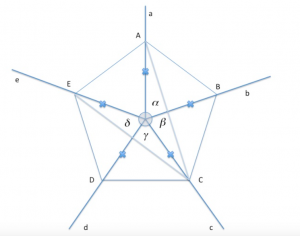[math]a[/math]
, [math]b[/math]
, [math]c[/math]
, [math]d[/math]
, [math]e[/math]
, tutte di origine [math]O[/math]
, formanti i quattro angoli congruenti [math]ab[/math]
, [math]bc[/math]
, [math]cd[/math]
, [math]de[/math]
. Su tali semirette prendi rispettivamente i punti [math]A[/math]
, [math]B[/math]
, [math]C[/math]
, [math]D[/math]
, [math]E[/math]
in modo che sia [math]OA = OB = OC = OD = OE [/math]
.Dimostra che
[math]AC = CE [/math]
e [math]AB = BC = CD = DE[/math]
.

Svolgimento
Consideriamo i triangoli[math]AOE[/math]
e [math]AOB[/math]
. Essi hanno:- [math]EO = BO[/math]per ipotesi;
- [math]AO[/math]in comune;
- [math]hat{EOA} = hat{AOB}[/math]per ipotesi;
[math]AOE[/math]
e [math]AOB[/math]
sono congruenti.Possiamo dedurre quindi che
[math]AE = AB[/math]
.Seguiamo lo stesso ragionamento per i triangoli
[math]BOC[/math]
, [math]COD[/math]
e [math]DOE[/math]
, tutti tra loro congruenti per il primo criterio di congruenza, avendo due lati e l'angolo fra essi compreso congruente.Abbiamo quindi dimostrato che
[math]AB = BC = CD = DE = EA[/math]
.
Ora consideriamo i triangoli
[math]AOC[/math]
e [math]EOC[/math]
; essi hanno:- [math]EO = AO [/math]per ipotesi;
- [math]OC[/math]in comune;
- [math]hat{EOC} = hat{AOC}[/math]perché somme di angoli congruenti;
[math]AOC[/math]
e [math]EOC[/math]
sono congruenti.In particolare risulta che
[math]AC = CE[/math]
.



